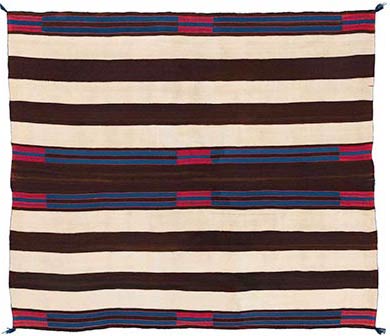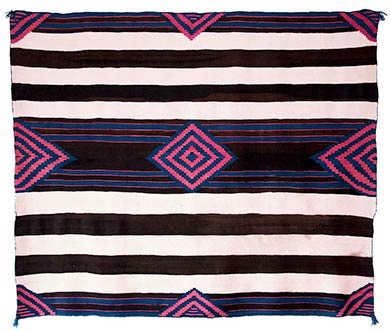Upper Left: A Classic First Phase Chief’s Blanket, Ute Style, Navajo, circa 1830
Upper Right: A Classic Bayeta Second Phase Chief’s Blanket, Navajo, circa 1850
Lower Left: A Classic Bayeta Third Phase Chief’s Blanket, Navajo, circa 1850
Lower Right: A Classic Chief’s Blanket Variant, Ute Style, Navajo, circa 1840
Classic Navajo Chief’s Blankets
Classic Navajo chief’s blankets were woven between 1800 and 1865. While some chief’s blankets were woven for Navajo men and women, the majority were woven as trade items and bartered to ranking members—or “chiefs”—of the Arapahoe, Blackfoot, Cheyenne, Kiowa, Lakota, or Ute tribes. Between 1800 and 1870, Plains and Prairie men and women wore Navajo chief’s blankets around their shoulders, as robes. By 1840, the chief’s blanket had replaced the buffalo robe as the most valuable trade item in North America, and was accepted both as a store of value and as a form of currency throughout the Southwest, the Great Plains, the Prairie, and the Missouri Valley.
Anglo-American explorers and military officers began collecting Navajo chief’s blankets during the 1850s. Between 1850 and 1870, the rate of exchange for one chief’s blanket was either ten buffalo hides, twenty horses, or fifty dollars in gold. In 1850, ten dollars was one month’s pay for a cavalry officer in the U. S. Army. The ten-dollar gold piece, or “eagle,” contained one-half of one ounce of gold.
First phase chief’s blankets have horizontally banded fields with no design elements. Ute Style first phases have alternating brown and white bands, with pairs of thin blue bands. Bayeta first phases have thin horizontal stripes of raveled red bayeta. While Ute Style first phases tend to pre-date bayeta first phases, it would be a mistake to assume that every Ute Style first phase was woven before every bayeta first phase.
Second phase chief’s blankets have horizontally banded fields with rectangular foreground designs, usually in the form of either concentric squares, concentric rectangles, or pairs of solid rectangular bars. Ute Style second phases have no thin red stripes connecting their design elements. Bayeta second phases have thin, horizontal red stripes that connect their design elements.
Third phase chief’s blankets have horizontally banded fields with diamond-shaped foreground designs. Ute Style third phases have no thin red stripes between their diamonds. Bayeta third phases have thin red stripes between their diamonds.
Navajo chief’s blankets that combine second and third phase designs are called variants. Chief’s blankets with designs appropriated from Navajo dress halves, mantas, poncho serapes, or serapes are also called variants.
Conventional wisdom holds that first phases were woven before second phases, and that second phases were woven before third phases and variants. Examination of the designs, weaving techniques, and yarns in classic Navajo chief’s blankets contradicts the conventional wisdom. While the first phase is the earliest form, classic first phases, second phases, third phases, and variants were not woven in chronological order. Between 1830 and 1860, certain second phases, third phases, and variants were woven before certain first phases.
Native American thought sees events as taking place in cycles, where the beginning, middle, and end of a cycle can occur simultaneously. Anglo-American thought starts at the beginning of a narrative, proceeds chronologically through the narrative, and finishes at the end. The study of classic Navajo chief’s blankets requires recognition of both styles of thought. The two styles do not contradict each other so much as they inform each other and fill in each other’s gaps.






